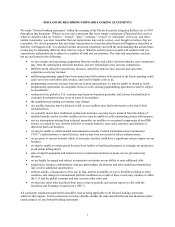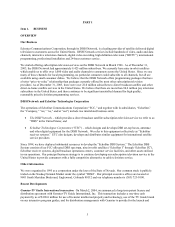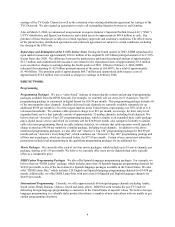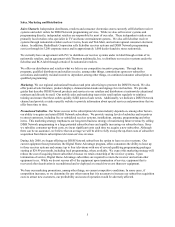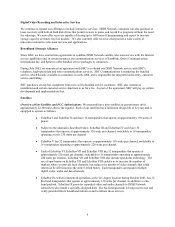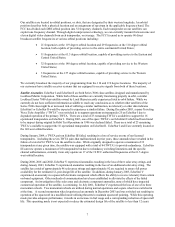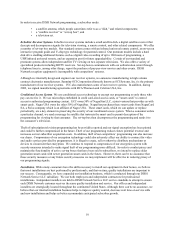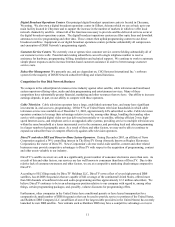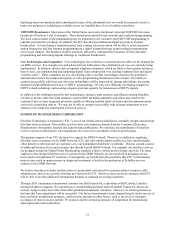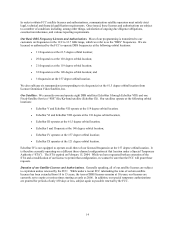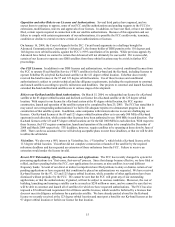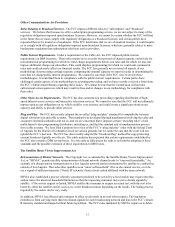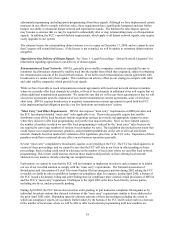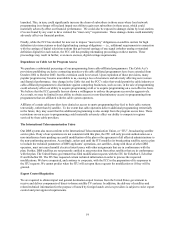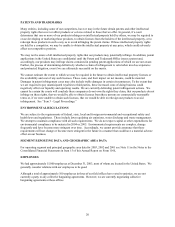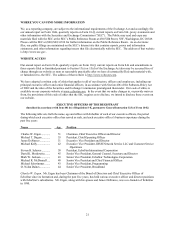Dish Network 2003 Annual Report Download - page 16
Download and view the complete annual report
Please find page 16 of the 2003 Dish Network annual report below. You can navigate through the pages in the report by either clicking on the pages listed below, or by using the keyword search tool below to find specific information within the annual report.11
Digital Broadcast Operations Centers. Our principal digital broadcast operations center is located in Cheyenne,
Wyoming. We also own a digital broadcast operations center in Gilbert, Arizona which we use as back up to our
main facility located in Cheyenne and to support the increase in the number of markets in which we offer local
network channels by satellite. Almost all of the functions necessary to provide satellite-delivered services occur at
the digital broadcast operations centers. The digital broadcast operations centers use fiber optic lines and downlink
antennas to receive programming and other data. These centers then uplink programming content to our direct
broadcast satellites. Equipment at our digital broadcast operations centers performs substantially all compression
and encryption of DISH Network’s programming signals.
Customer Service Centers. We currently own or operate nine customer service centers fielding substantially all of
our customer service calls. Potential and existing subscribers can call a single telephone number to receive
assistance for hardware, programming, billing, installation and technical support. We continue to work to automate
simple phone responses and to increase Internet-based customer assistance in order to better manage customer
service costs.
Subscriber Management. We presently use, and are dependent on, CSG Systems International Inc.’s software
system for the majority of DISH Network subscriber billing and related functions.
Competition for Our Dish Network Business
We compete in the subscription television service industry against other satellite, cable television and land-based
system operators offering video, audio and data programming and entertainment services. Many of these
competitors have substantially greater financial, marketing and other resources than we have. Our ability to increase
earnings depends, in part, on our ability to compete with these operators.
Cable Television. Cable television operators have a large, established customer base, and many have significant
investments in, and access to, programming. Of the 97% of United States television households in which cable
television service was available as of December 31, 2003, approximately 64% subscribed to cable. Cable television
operators continue to leverage their advantages relative to us by, among other things, bundling their analog video
service with expanded digital video services delivered terrestrially or via satellite, offering efficient 2-way high-
speed Internet access, and telephone service on upgraded cable systems, providing service to multiple television sets
within the same household at a lesser incremental cost to the consumer, and providing local and other programming
in a larger number of geographic areas. As a result of these and other factors, we may not be able to continue to
expand our subscriber base or compete effectively against cable television operators.
DirecTV and other DBS and Direct-to-Home System Operators. During December 2003, an affiliate of News
Corporation acquired a 34% controlling interest in The DirecTV Group (formerly known as Hughes Electronics
Corporation), the owner of DirecTV. News Corporation’s diverse world-wide satellite, content and other related
businesses may provide competitive advantages to DirecTV with respect to the acquisition of programming, content
and other assets valuable to our industry.
DirecTV’s satellite receivers are sold in a significantly greater number of consumer electronics stores than ours. As
a result of this and other factors, our services are less well known to consumers than those of DirecTV. Due to this
relative lack of consumer awareness and other factors, we are at a competitive marketing disadvantage compared to
DirecTV.
According to SEC filings made by DirecTV Holdings LLC, DirecTV owns a fleet of seven high powered DBS
satellites, has 46 DBS frequencies that are capable of full coverage of the continental United States, offered more
than 800 channels of combined video and audio programming and has approximately 12.2 million subscribers. We
believe DirecTV continues to be in an advantageous position relative to our company with regard to, among other
things, certain programming packages, and, possibly, volume discounts for programming offers.
Furthermore, other companies in the United States have conditional permits or have leased transponders for a
comparatively small number of DBS frequencies that can be used to provide service to portions of the United States,
and Rainbow DBS Company LLC (an affiliate of one of the largest cable providers in the United States) has recently
launched its own DBS satellite. New entrants such as Rainbow DBS may have a competitive advantage over us in


